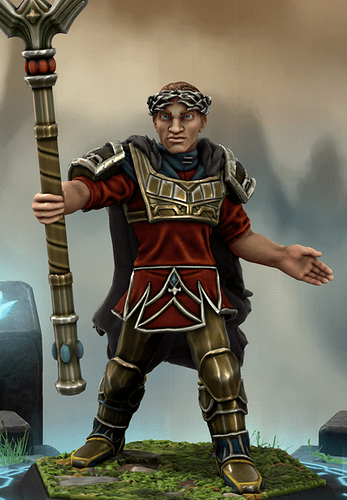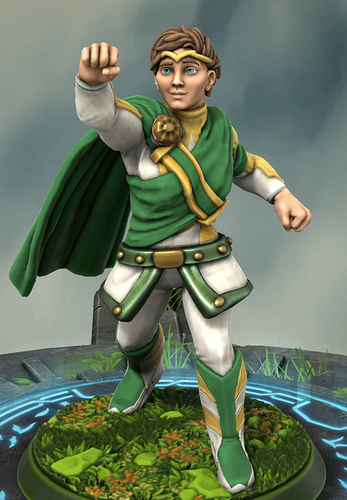Thanks, it was pretty good.
The Randomizers:
Background 1, 7, 7 [Options: Blank Slate, Law Enforcement, Struggling, Interstellar, Anachronistic]
Power Source 9, 8, 7 [Options: Relic, Powered Suit, Radiation, Genius, Cosmos, Extradimensional]
Archetype 4, 6, 5 [Options: Marksman, Blaster, Armored, Elemental Manipulator, Robot/Cyborg, Sorcerer]
Personality 9, 1, 1 [Options: Lone Wolf, Natural Leader, Inquisitive, Stoic, Nurturing]
Horizon
Real Name: Aurelia Xur, First Appearance: Broken Mirrors #21, Dec 1986
Background: Anachronistic, Power Source: Cosmos, Archetype: Armored
Personality: Natural Leader, Principles: Outsider, Indestructible
Status Dice: Green d6, Yellow d8, Red d10. Health: 32 [Green 32-25, Yellow 24-12, Red 11-1]
Qualities: Close Combat d10, Technology d10, Leadership d8, Child of Two Worlds d8
Powers: Size Control d10, Strength d10, Gadgets d8, Intuition d8, Plant Control d8
Green Abilities:
-
Enhanced Physique (I): Reduce any physical or energy damage you take by 1 while you are in the Green zone, 2 while in the Yellow zone, and 3 while in the Red zone.
-
Wade In [A]: Attack using Strength. Attack a second target with your Min die.
-
Plant Shield [A]: Attack using Plant Control. Defend another target with your Min die.
-
Reflection Field [R]: Double the damage reduction effect of Enhanced Physique against one Attack, then deal damage to a nearby target equal to the total damage reduced in this way.
-
Principle of the Outsider [A]: Overcome a local problem using knowledge from your home and use your Max die. You and each of your allies gain a hero point.
-
Principle of the Indestructible [A]: Overcome in a situation where you charge headlong into danger and use your Max die. You and each of your allies gain a hero point.
Yellow Abilities:
-
Into the Breach [A]: Attack using Size Control. Boost all nearby heroes taking Attack or Overcome actions using your Min die until your next turn.
-
Natural Immunity (I): If you would take Toxic damage, instead reduce that damage to 0 and Recover that amount of Health.
Red Abilities
-
Growth Through Adversity [R]: When you are Attacked, roll your single Size Control die as a Defend against that Attack. Also Boost yourself with the same roll.
-
Enhanced Technologist [A]: Overcome using Technology. Use your Max+Min dice.
Out
- Boost an ally by rolling your single Technology die.
In December of 1986, after a handful of relatively direct storylines, Broken Mirrors decided to look to the future. More precisely, it explored an alternate future set in the faraway year of 1999, in which a new generation of Champions defended the Earth from external threats. The team’s leader was Horizon, the size-changing daughter of the Steward and Greenheart.
In this timeline, the two heroes had fallen in love in the 1960s, and had lived together for some time; when Cassandra was just a baby, however, the Steward had finally succumbed to his illness and passed away. Cassandra thus grew up in True Rome, displaying powers from a young age. The Steward’s genetic illness and Greenheart’s mastery of nature combined within her, giving her an immense mastery over her own physical form and an immunity to toxins and disease; it was only natural that she would, once she struck out on her own, take up the mantle of heroism herself.
Over the course of three issues, the Drifter met the Champions of Tomorrow, Horizon’s team, and helped them overcome the nightmarish seed that had been planted in the heart of their world - a threat composed of a techno-organic monstrosity constructed by a team-up between Dr. Freak and Hive-Minder that had consumed both villains. This was meant to be the end of the story, but the possibilities of a future world resonated with readers, and in May 1987 Venture launched New Horizons, meant to be a Horizon-focused ongoing title.
Despite initial anticipation, New Horizons began to lose sales within a few months of its release. The writers chose to play it safe, introducing nothing but legacy characters who were essentially the same as their prior incarnations, and while Horizon herself was interesting, her initial storylines were not. Fan support managed to keep the series running up to twenty-four issues, but it was ultimately cancelled in 1989. A few of the concepts from New Horizons endured into the Venture universe: Skybreaker’s son becoming the hero Cloudskimmer was ultimately used in the 2019 timeskip, and some of the ideas in New Horizons were taken up by Paradox’s own future in Company Town. But overall, Horizon and her adventures became no more than an interesting footnote in the history of Venture Comics.
Behind the Scenes
And that’s what I was mentioning in the Q&A!
This is Venture’s thrust into alternate realities as a full comic; if it had succeeded, they might have tried to make it two or three things. But they didn’t go hard enough, and the rest of the line was moving in a different direction, so it sort of petered out instead.


